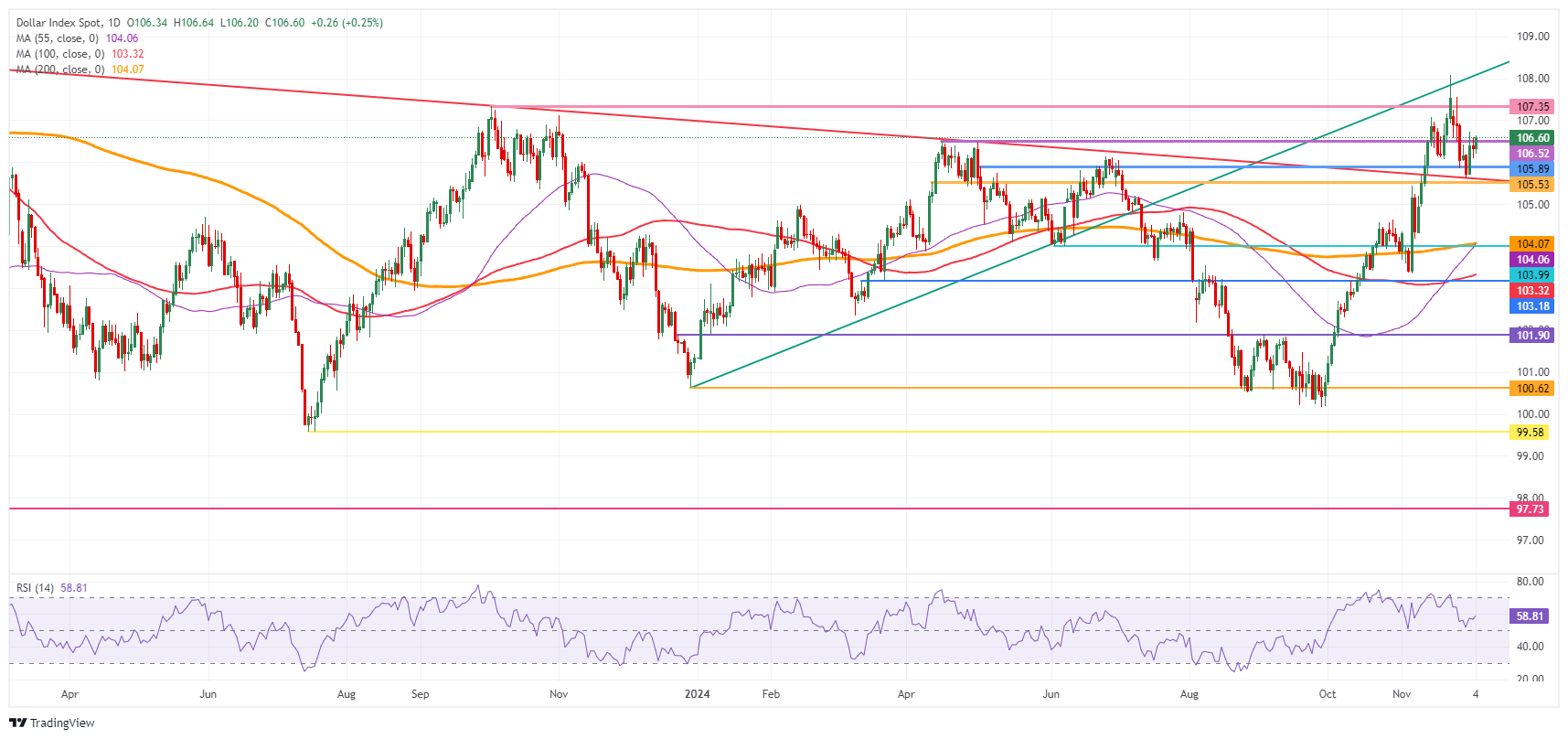- The US Dollar whipsaws on Wednesday and turns red after both S&P and ISM Services release.
- Federal Reserve Bank of St. Louis President Alberto Musalem delivers hawkish comment.
- Fed Chairman Powell is set to speak during the American session, likely adding volatility to the US Dollar Dollar Index.
The US Dollar (USD) is turning red after numbers on the US Services sector from S&P global and the Institute for Supply Management fell short of expectations, while a no-confidence vote in France is taking place. Chances that Prime Minister Michel Barnier will survive the vote are slim to nil, with President Emmanuel Macron forced to select a new prime minister to form a new government in the coming weeks. Meanwhile, in the US, traders are starting to keep their powder dry ahead of Friday's US Jobs Report.
On the economic data front, all data is now out of the way. The Services Purchasing Manager Index (PMI) for November came in as a downbeat surprise with all components falling under their estimated result. The ADP private payroll estimate held no surprise and was a very small miss on estimates, not moving the needle. Late in the US trading session, Federal Reserve (Fed) Chairman Jerome Powell will speak at the New York Times DealBook Summit in New York.
Daily digest market movers: ISM and S&P contradict Fed's Musalem
- The ADP Job Change numbers for November comes in a touch softer at 146,000, below the 150,000 estimate and down from 233,000 in October.
- S&P Global has released its final reading of its November numbers for the Purchasing Managers Index. The services index came in at 56.1, missing the 57 estimate and initial reading, while the Composite fell to 54.9, lower than the previous 55.3.
- The Institute for Supply Management has release its November survey for the Services sector. The headline PMI fell to 52.1, undershooting the 55.5 expected and far below the 56 previously.
- Three Federal Reserve members will speak this Wednesday:
- at 13:45 GMT, Federal Reserve Bank of St. Louis President Alberto Musalem has delivered a keynote speech on "Monetary Policymaking: Central Banking in a Changing World" at the College of Central Bankers Symposium in New York City, United States. Fed's Musalem commented that a rate cut in December is too big of a gamble seeing the recent geopolitical tensions and activities that could spark a fresh inflation surge, Bloomberg reported.
- Around 18:45 GMT, Federal Reserve Chairman Jerome Powell participates in a discussion at the New York Times DealBook Summit in New York.
- Closing off at 23:00 GMT, Federal Reserve Bank of San Francisco President Mary Daly is interviewed at PBS New Hour.
- Equities are heading through and are positive throughout the trading day in both Europe and the US ahead of Fed Chairman Jerome Powell.
- The CME FedWatch Tool is pricing in another 25 basis points (bps) rate cut by the Fed at the December 18 meeting by 73.8%. A 26.2% chance is for rates to remain unchanged. The Fed Minutes and recent comments from several Fed officials have helped the rate cut odds for December to move higher.
- The US 10-year benchmark rate trades at 4.23%, ticking up from the 4.21% seen on Tuesday.
US Dollar Index Technical Analysis: Nothing moving despite a lot of moving parts
The US Dollar Index (DXY) is ticking up slightly ahead of the Nonfarm Payrolls print of Friday. After the turmoil at the start of the week on the back of the French political stage, it looks that traders want to keep their powder dry going into Friday’s Jobs Report. Although Fed Chairman Jerome Powell is set to speak, not manyuch market- moving comments are expected.
On the upside, 106.52 (April 16 high) remains as the first resistance to look at after failing to close above it this week. Should the US Dollar bulls reclaim that level, 107.00 (round level) and 107.35 (October 3, 2023, high) are back on target for a retest.
Looking down,Should the French government fall and a new, more stable, government formation is set to take place, the pivotal level at 105.53 (April 11 high) comes into play before heading into the 104-region. Should the DXY fall all the way towards 104.00, the big figure and the 200-day Simple Moving Average at 104.03 should catch any falling knife formation.
US Dollar Index: Daily Chart
(This story was corrected on December 04 at 13:58 GMT to say Closing off at 23:00 GMT, Federal Reserve Bank of San Francisco President Mary Daly is interviewed at PBS New Hour, not 13:00 GMT)
Central banks FAQs
Central Banks have a key mandate which is making sure that there is price stability in a country or region. Economies are constantly facing inflation or deflation when prices for certain goods and services are fluctuating. Constant rising prices for the same goods means inflation, constant lowered prices for the same goods means deflation. It is the task of the central bank to keep the demand in line by tweaking its policy rate. For the biggest central banks like the US Federal Reserve (Fed), the European Central Bank (ECB) or the Bank of England (BoE), the mandate is to keep inflation close to 2%.
A central bank has one important tool at its disposal to get inflation higher or lower, and that is by tweaking its benchmark policy rate, commonly known as interest rate. On pre-communicated moments, the central bank will issue a statement with its policy rate and provide additional reasoning on why it is either remaining or changing (cutting or hiking) it. Local banks will adjust their savings and lending rates accordingly, which in turn will make it either harder or easier for people to earn on their savings or for companies to take out loans and make investments in their businesses. When the central bank hikes interest rates substantially, this is called monetary tightening. When it is cutting its benchmark rate, it is called monetary easing.
A central bank is often politically independent. Members of the central bank policy board are passing through a series of panels and hearings before being appointed to a policy board seat. Each member in that board often has a certain conviction on how the central bank should control inflation and the subsequent monetary policy. Members that want a very loose monetary policy, with low rates and cheap lending, to boost the economy substantially while being content to see inflation slightly above 2%, are called ‘doves’. Members that rather want to see higher rates to reward savings and want to keep a lit on inflation at all time are called ‘hawks’ and will not rest until inflation is at or just below 2%.
Normally, there is a chairman or president who leads each meeting, needs to create a consensus between the hawks or doves and has his or her final say when it would come down to a vote split to avoid a 50-50 tie on whether the current policy should be adjusted. The chairman will deliver speeches which often can be followed live, where the current monetary stance and outlook is being communicated. A central bank will try to push forward its monetary policy without triggering violent swings in rates, equities, or its currency. All members of the central bank will channel their stance toward the markets in advance of a policy meeting event. A few days before a policy meeting takes place until the new policy has been communicated, members are forbidden to talk publicly. This is called the blackout period.
Information on these pages contains forward-looking statements that involve risks and uncertainties. Markets and instruments profiled on this page are for informational purposes only and should not in any way come across as a recommendation to buy or sell in these assets. You should do your own thorough research before making any investment decisions. FXStreet does not in any way guarantee that this information is free from mistakes, errors, or material misstatements. It also does not guarantee that this information is of a timely nature. Investing in Open Markets involves a great deal of risk, including the loss of all or a portion of your investment, as well as emotional distress. All risks, losses and costs associated with investing, including total loss of principal, are your responsibility. The views and opinions expressed in this article are those of the authors and do not necessarily reflect the official policy or position of FXStreet nor its advertisers. The author will not be held responsible for information that is found at the end of links posted on this page.
If not otherwise explicitly mentioned in the body of the article, at the time of writing, the author has no position in any stock mentioned in this article and no business relationship with any company mentioned. The author has not received compensation for writing this article, other than from FXStreet.
FXStreet and the author do not provide personalized recommendations. The author makes no representations as to the accuracy, completeness, or suitability of this information. FXStreet and the author will not be liable for any errors, omissions or any losses, injuries or damages arising from this information and its display or use. Errors and omissions excepted.
The author and FXStreet are not registered investment advisors and nothing in this article is intended to be investment advice.
Recommended content
Editors’ Picks

EUR/USD maintains its constructive tone near 1.1400
EUR/USD remains well bid in the proximity of the 1.1400 hurdle on Thursday, deriving support from the renewed selling pressure in the US Dollar as investors continue to assess the ongoing absence of further progress in the US-China trade conflict.

GBP/USD appears sidelined around 1.3300, USD remains offered
GBP/USD holds its ground near the 1.3300 mark on Thursday amid a strong rebound in the broader risk-linked universe, all against tha backdrop of renewed weakness around the Greenback and steady uncertainty over US–China trade relations.

Gold eases from tops, back near $3,300
Gold manages to regain composure and reverses two daily drops in a row, currently approaching the $3,300 mark per troy ounce following the earlier bull run to the boundaries of $3,370. Furthermore, XAU/USD attracted safe-haven flows amid renewed concerns of a US-China trade flare-up.

Bitcoin Price corrects as increased profit-taking offsets positive market sentiment
Bitcoin (BTC) is facing a slight correction, trading around $92,000 at the time of writing on Thursday after rallying 8.55% so far this week. Institutional demand remained strong as US spot Exchange Traded Funds (ETFs) recorded an inflow of $916.91 million on Wednesday.

Five fundamentals for the week: Traders confront the trade war, important surveys, key Fed speech Premium
Will the US strike a trade deal with Japan? That would be positive progress. However, recent developments are not that positive, and there's only one certainty: headlines will dominate markets. Fresh US economic data is also of interest.

The Best brokers to trade EUR/USD
SPONSORED Discover the top brokers for trading EUR/USD in 2025. Our list features brokers with competitive spreads, fast execution, and powerful platforms. Whether you're a beginner or an expert, find the right partner to navigate the dynamic Forex market.



